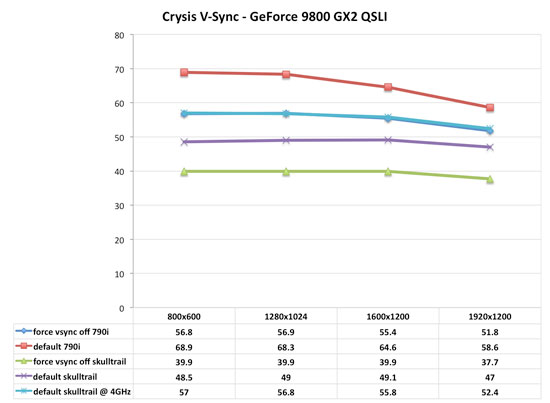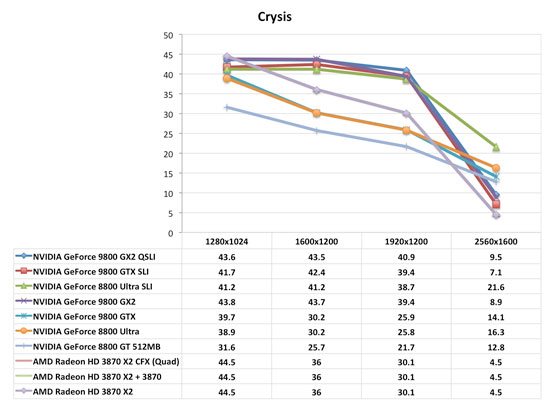GeForce 9800 GTX and 3-way SLI: May the nForce Be With You
by Derek Wilson on April 1, 2008 9:00 AM EST- Posted in
- GPUs
Crysis, DX10 and Forcing VSYNC Off in the Driver
Why do we keep on coming back to Crysis as a key focal point for our reviews? Honestly because it’s the only thing out there that requires the ultra high end hardware enabled by recently released hardware.
That and we’ve discovered something very interesting this time around.
We noted that some of our earlier DX10 performance numbers on Skulltrail looked better than anything we could get more recently. In general, the higher number is usually more likely to be "right", and it has been a frustrating journey trying to hunt down the issues that lead to our current situation.
Many reinstalls and configuration tweaks later and we’ve got an answer.
Every time I set up a system, because I want to ensure maximum performance, the first thing I do is force VSYNC off in the driver. I also generally run without having the graphics card scale output for my panel; centered timings allow me to see what resolution is currently running without having to check. But I was in a hurry on Sunday and I must have forgotten to check the driver after I set up an 8800 Ultra SLI for testing Crysis.
Low and behold, when I looked at the numbers, I saw a huge performance increase. No, it couldn’t be that VSYNC was simply not forced off in the driver could it? After all, Crysis has a setting for VSYNC and it was explicitly disabled; the driver setting shouldn’t matter.
But it does.
Forcing VSYNC off in the driver can decrease performance by 25% under the DX10 applications we tested. We see a heavier impact in CPU limited situations. Interestingly enough, as we discussed last week, with our high end hardware, Crysis and World in Conflict were heavily CPU and system limited. Take a look for yourself at the type of performance gains we saw from disabling VSYNC. These tests were run on Crysis using the GeForce 9800 GX2 in Quad SLI.

We would have tried overclocking the 790i system as well if we could have done so and maintained stability.
In looking at these numbers, we can see some of the major issues we had between NVIDIA platforms and Skulltrail diminish. There is still a difference, but 790i does have PCIe 2.0 bandwidth between its cards and it uses DDR3 rather than FB-DIMMS. We won’t be able to change those things, but right now my option is to run half the slots with 800 MHz FB-DIMMS or all four slots with 667 MHz. We should be getting a handful of higher speed lower latency FB-DIMMS in for testing soon which will we believe will help. Now that we’ve gotten a better feel for the system, we also plan on trying some bus overclocking to help alleviate the PCIe 2.0 bandwidth advantage 790i has. It also seems possible to push our CPUs up over 4GHz with air cooling, but we really need a larger PSU to keep the system stable (without any graphics going, a full CPU load can pull about 700W at the wall when running 4GHz at 1.5v) especially when you start running a GPU on top of that.
Slower GPUs will benefit less from not forcing VSYNC off in the driver, but even if the framerate is near a CPU limit (say, within 20%) performance will improve. NVIDIA seems more impacted by this than AMD, but we aren’t sure at this point whether that is because NVIDIA’s cards expose more of a CPU limit due to their higher performance.
NVIDIA is aware of the VSYNC problem, as they were able to confirm our findings yesterday.
Being that we review hardware, it is conceivable that this issue might not affect most gamers. Many people like VSYNC on, and since most games allow for the option it isn’t usually necessary or beneficial to force VSYNC off in the driver. So we decided to ask in our video forum just how many people force VSYNC off in the driver, and whether they do so always or just some of the time.
More than half our 89 respondents (at the time of this writing) never force VSYNC off, but 40% of the remaining respondents admitted to forcing VSYNC off at some point, half of these always forcing VSYNC off (just as we do in our testing).
This is a big deal, especially for members who want to play Crysis and have lower end CPUs. We didn’t have time to rerun all of our numbers without VSYNC forced off in the driver, so keep in mind that these numbers could benefit a lot by doing so.











49 Comments
View All Comments
nubie - Tuesday, April 1, 2008 - link
It is all well and good to bash nVidia for lack of SLi support on other systems, but why can't the AMD cards run on an nVidia motherboard? Kill 2 birds with one stone there, lose your FB-Dimms and test on a single platform.Apples to apples, you can't say nVidia is at fault when the blame isn't entirely theirs (besides, isn't the capability to run Crossfire and SLi on one system a little out of the needs of most users?).
Is it that AMD allows crossfire on all Except nVidia motherboards? (Do VIA, or SiS make a multi-PCIe board?) If so, then we are talking Crossfire availability on Intel and AMD chipsets, and not nvidia, whereas nVidia allows only their own. That sounds like 30/70% blame AMD vs nVidia.
PeteRoy - Tuesday, April 1, 2008 - link
It is too hard to understand these graphs, use the ones you had in the past, I can't understand how to compare the different systems in these graphs.Use the graphs from the past with the best on top and the worst on bottom.
araczynski - Tuesday, April 1, 2008 - link
i'm using a 7900gtx right now, and the 9800gtx isn't impressing me enough to warrant $300, i might just pick up an 8800gts512 in a month when they're all well below $200. overclocking one would be more than "close enough" for me.araczynski - Tuesday, April 1, 2008 - link
... in any case, i'd much prefer to see benchmarks comparing a broader range of cards than seeing this sli/tri/quad crap. your articles are assuming that everyone upgrades their cards everytime nvidia/ati shit something out on a monthly basis.Denithor - Tuesday, April 1, 2008 - link
...because they set out to accurately compare nVidia's latest high end card to other high end options available.I'm sure in a few days there will be a followup article showing a broader spectrum of cards at more usable resolutions so we (the common masses) can see whether or not this $300 card really brings any benefit with its high price tag.
Ndel - Tuesday, April 1, 2008 - link
your benchmarks dont even make any sense =/why use a system 99.9 percent of the people dont have.
this is not even relative to what other enthusiasts currently have, how are we suppose to believe these benchmarks at all.
grain of salt...
SpaceRanger - Tuesday, April 1, 2008 - link
I believe he used the fastest processor out there to eliminate IT at the bottleneck for the benchmark.Rocket321 - Tuesday, April 1, 2008 - link
Derek -I enjoyed this article for a few reasons that made it different.
First, the honesty and discussion of problems expirenced. This helps to convay the many issues still expirenced with multi GPU solutions.
Second the youtube video. This is a neat use of available technology. Could this be useful in other ways? Maybe in the next low/mid GPU roundup it could be used to show a short clip of each card playing a game at the same point.
This could visually show where one card gets choppy and a better card doesn't.
Finally - Using a poll in the forums - really great idea to do this for relavent info and then add to an article.
Thanks for the good article!
chizow - Tuesday, April 1, 2008 - link
Thanks for making AT reviews worth reading again Derek. You addressed many of the problems I've had with the ho-hum reviews of late, like emphasizing major problems encountered during testing and dropping some incredibly insightful discoveries backed by convincing evidence (Vsync issue). Break throughs such as this are part of what make PC hardware fun and exciting.A few things you touched on but didn't really clarify was performance on Skulltrail vs. NV chipsets and memory bandwidth/amount on the 9800 vs. Ultra. I'd like to see a comparison of Skulltrail vs. 780/790i and then just future disclaimers like (Skulltrail is ~20% slower than the fastest NV solutions).
With the 9800 vs Ultra I'm a bit disappointed you didn't really dig into overclocking at all or further investigation on how much some of the issues you talked about impacted or benefitted performance, like memory bandwidth. I think its safe to say the 9800GTX as a refined G92 8800GTS has significant overclocking headroom while the Ultra does not (its basically an overclocked GTX). It would have been nice to see how much memory overclocks would've benefitted overall performance alone, then max overclocks on both the core/shader and memory.
But again, great review, I'll be reading over it again to pick up on some of the finer details.
lopri - Tuesday, April 1, 2008 - link
How many revisions the 790i have been through already? Major ones at that. Usually minor revisions are like A0->A1->A2, I thought. As a matter of fact I don't even remember if there was any nVidia chip that is 'C' revision, except maybe MCP55 (570 SLI).